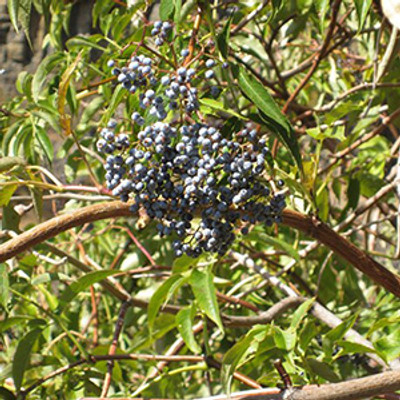Blue Elderberry ~ Bundle of 3 Bare-root


- Current Stock:
- 0
- Other Names:
- Velvet-leaf Elder, Dwarf Elder, Blue Elder
- Latin Name:
- Sambucus caerulea
Edible Uses
Blue Elderberry is a deciduous fruit tree native to Western North America. Elderberries have been an important native food and medicine source for thousands of years - but only the blue and purple-berried species are edible. Berries and flowers can be eaten fresh, but are best cooked or made into elderberry wine, jam, syrup, and pies. The entire flower cluster can be dipped in batter and fried, while petals can be eaten raw or made into a fragrant and tasty tea. The flowers add an aromatic flavor and lightness to pancakes or fritters.
The fruit and flowers are very nutritious and medicinal - they contain high levels of antioxidants, vitamin C, and Vitamin A. The flowers contain flavonoids and rutin, which are known to improve immune function. NOTE: Flavor improves with cooking. Raw berries contain compounds that should not be consumed in large quantities. Leaves and stems are toxic.
Ornamental Qualities
Blue Elderberry is an attractive fruit-bearing ornamental in the home landscape. Its graceful pointed leaves and long purple-tinted stems give way to large sprays of white blossoms in late Spring, followed by bunches of powdery blue berries soon after.
Environment and Culture
Blue Elderberry can adapt and thrive in many different environments. It is fast-growing, but is easily pruned to keep small or in shape. It is a vigorous grower with shallow roots and can perform well as a deciduous edible hedge or windscreen. Once established, it is very low-maintenance for it’s lifetime, making it a great plant for the lazy gardener - and if you don’t harvest its fruit, the wildlife surely will! Native Americans used virtually every part of this special tree for either food, medicine, or materials to make tools.
Harvest, Care, and Preparation
Second-year elderberry canes with good lateral development are the most fruitful - prune to emphasize these. Harvest flower clusters from tree when in full bloom and fragrance. Clip berry clusters whole from tree when fully blue and soft, and strip from cluster for use. Once harvested, use the fruit as soon as possible or keep at a cool temperature. Berries and flowers can be eaten raw, but are much better cooked and added to other dishes such as pancakes, fritters, pies, cobblers, or puddings. Or, add sweetener and cook down into a syrup on the stove to be stored or used in any dish that needs a rich berry flavor. Stay tuned for more recipes!
- Native Range: Western States
- USDA zones: 4-10
- Ease of Care: Easy - once established
- Deer Resistance: Moderate
- Light Requirements: Full Sun
- Soil Type: Any, prefers well-drained, slightly acidic
- Water Requirements: Moist
- Pollination: Self-fertile, but bigger fruiting with an additional variety as pollinator
- Bearing Age: 3 years
- Size at Maturity: 6-16 feet, easily pruned
- Plant Spacing: 8-15ft
- Bloom Time: Late Spring, white flower clusters
- Harvest Time: Late Summer/Fall
Pot Sizing Guide







